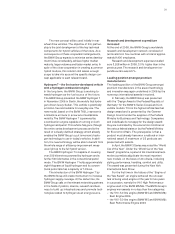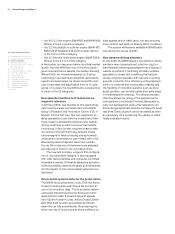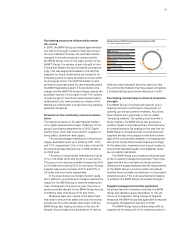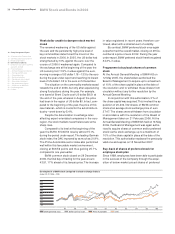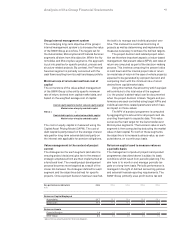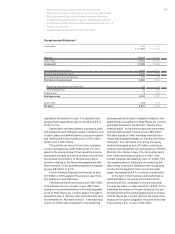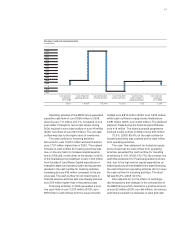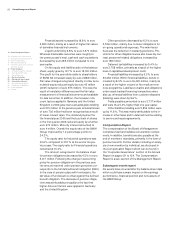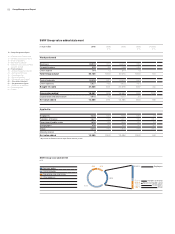BMW 2006 Annual Report Download - page 44
Download and view the complete annual report
Please find page 44 of the 2006 BMW annual report below. You can navigate through the pages in the report by either clicking on the pages listed below, or by using the keyword search tool below to find specific information within the annual report.
43
Analysis of the Group Financial Statements
Group internal management system
The underlying long-term objective of the group’s
internal management system is to increase the value
of the BMW Group as a whole. The targets set for
the Automobiles, Motorcycles and Financial Services
segments all stem from this objective. Within the Au-
tomobiles and Motorcycles segments, this approach
is put into practise for specific product, process and
structure-related projects. By contrast, the Financial
Services segment is primarily concerned with the
cash flows resulting from its credit and lease portfolio.
Minimum rate of return derived from cost of
capital
The cornerstone of the value-added management
of the BMW Group is the entity-specific minimum
rate of return, derived from capital market data, and
based on the weighted average cost of capital:
Cost of equity capital x market value of equity capital
Market value of equity and debt capital
WACC = +
Cost of debt capital x market value of debt capital
Market value of equity and debt capital
The cost of equity capital is measured using the
Capital Asset Pricing Model (CAPM). The cost of
debt capital is partly based on the average interest
rate paid for long-term external debt and partly on
the interest rate applicable for pension obligations.
Value management in the context of project
control
The strategies set for each segment (and also the
ensuing project decisions) give rise to the areas of
strategic emphasis which are then implemented at
a functional level. The overall project development
process becomes more targeted as a result of the
closer link between the strategies defined for each
segment and the objectives defined for specific
projects. Once a project decision has been reached,
the task is to manage each individual project over
time. This involves the continual monitoring of
projects as well as determining and implementing
measures necessary to achieve the defined targets.
The project decision and related project selec-
tion are therefore important aspects of value-based
management. Net present values (NPVs) and rates of
return are computed as part of the decision-making
process. This involves computing the present value
of cash flows and the internal project rate of return
(or model rate of return in the case of vehicle projects)
expected to be generated by a project decision and
comparing them with the minimum rate of return
derived from capital market data.
Using this method,the amount by which aproject
will contribute to the total value of the segment
(i.e. the project’s added-value) can be documented
when the project decision is taken. Targets and per-
formance are each controlled using target NPVs and
individual cash flow-related parameters which have
an impact on those values.
The NPV of a project programme is computed
by aggregating the amounts for all projects and dis-
counting them back to a specific date. This value
serves as the main target for the Automobiles and
Motorcycles segments. The business value of each
segment is then computed by deducting the market
value of debt capital. For both of these segments,
the objective is to increase business value, as com-
puted above, on a continuous basis.
Return on capital used to measure value on
a periodic basis
The management of product projects and product
programmes described above is subject to basic
conditions which result from periodic planning.The
aim here is to monitor and manage periodic tar-
gets
on a long-term basis. Periodic performance is
managed in the light of defined accounting policies
and external financial reporting requirements.The
BMW Group primarily uses profit before tax and
Key performance indicators 2006 2005 2004*2003 2002
in %
*adjusted for new accounting treatment of pension obligations
Return on Capital Employed
Automobiles 21.7 23.2 25.4 23.8 30.1
Motorcycles 17.7 17.8 10.4 16.7 22.3
Return on Assets
Financial Services 1.4 1.3 1.4 1.4 1.4
BMW Group 6.3 5.6 6.5 6.6 7.6


